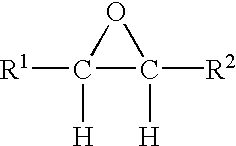Alkylene oxide catalysts having enhanced activity and/or stability
- Summary
- Abstract
- Description
- Claims
- Application Information
AI Technical Summary
Benefits of technology
Problems solved by technology
Method used
Image
Examples
examples
The following examples are by way of illustration only and are not to be construed as limiting the scope of the invention described herein.
Silver and promoter concentrations for all catalysts described in the specification are calculated values as described above.
Unless otherwise specified, carriers are nominally ring shaped having dimensions of about 1 / 8.times.5 / 16.times.5 / 16 inch or about 1 / 8.times.1 / 4.times.1 / 4 inch.
The following carriers are employed in one or more of the present examples.
Carrier "N"
Chemical Composition of Carrier "N"
alpha-Alumina at least about 98 wt. %
Acid Leachable Impurities
Leachate contained 378 ppm sodium and 330 ppm potassium.
Carrier S
Carrier S is an alpha-alumina carrier prepared by calcining a boehmite-ammonium bifluoride mixture containing 3 weight percent of ammonium bifluoride first at about 600.degree. C. and calcining again at about 1025.degree. C. The chemical and physical properties of the carrier are given below:
Water Leachable Impurities
6 ppm a...
examples 1-3
The preparation technique for the catalysts of Examples 1 (comparative), 2, and 3 is as follows. For the first impregnation, a weighed amount of carrier S is placed in an impregnation vessel. The vessel is evacuated using a mechanical vacuum pump and the designated stock silver solution is added. The solution is allowed to contact the carrier for 30 minutes at atmospheric pressure and is then allowed to drain from the carrier for 15 minutes. The first impregnated carrier is calcined in air on a belt roaster using the following procedure. The first impregnated carrier is spread out in a single layer and transported on a stainless steel belt through a 2 in. by 2 in. square heating zone in 2.5 minutes. Hot air, heated externally by a tubular furnace, is discharged from a port immediately below the belt at about 500.degree. C. at a rate of 66 standard cubic feet per hour per square inch. The roasted carrier is then returned to the impregnation vessel for the second impregnation. The sol...
examples 4-6
The preparation technique for the catalyst of Example 4 (comparative) is as follows. For the first impregnation, 59.57 weight parts of Carrier V is placed in an impregnation vessel. The vessel is evacuated and 186.3 weight parts of stock silver solution (Type C) is added. The solution is allowed to contact the carrier for 30 minutes at atmospheric pressure and is then allowed to drain from the carrier for 15 minutes. The first impregnated carrier is calcined in air on a belt roaster using the following procedure. The first impregnated carrier is spread out in a single layer and transported on a stainless steel belt through a 2 in. by 2 in. square heating zone in 2.5 minutes. Hot air, heated externally by a tubular furnace, is discharged from a port immediately below the belt at about 500.degree. C. at a rate of 66 standard cubic feet per hour per square inch. The roasted carrier is then returned to the impregnation vessel for the second impregnation. The solution for the second impr...
PUM
| Property | Measurement | Unit |
|---|---|---|
| Percent by mass | aaaaa | aaaaa |
| Percent by mass | aaaaa | aaaaa |
| Temperature | aaaaa | aaaaa |
Abstract
Description
Claims
Application Information
 Login to View More
Login to View More - R&D
- Intellectual Property
- Life Sciences
- Materials
- Tech Scout
- Unparalleled Data Quality
- Higher Quality Content
- 60% Fewer Hallucinations
Browse by: Latest US Patents, China's latest patents, Technical Efficacy Thesaurus, Application Domain, Technology Topic, Popular Technical Reports.
© 2025 PatSnap. All rights reserved.Legal|Privacy policy|Modern Slavery Act Transparency Statement|Sitemap|About US| Contact US: help@patsnap.com

